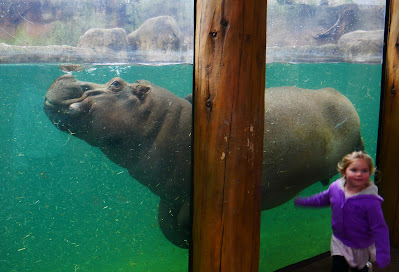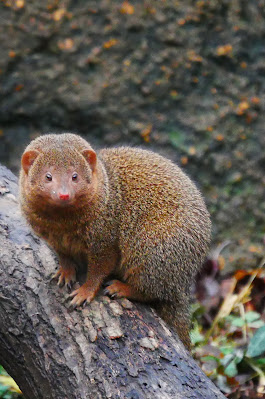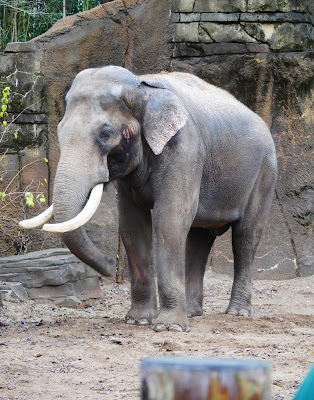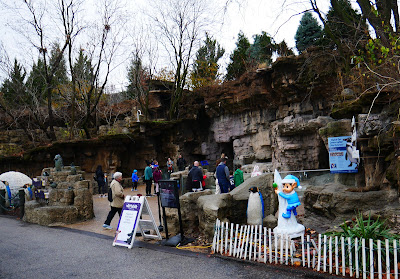The Butterfly House
Tuesday, December 31, 2024
St. Louis Zoo: Insectorium
Leaving the River Side series of habitats at the St. Louis Zoo, our intention was to leave, but then the Big House was right there. What could it hurt?
St. Louis Zoo: River's Edge
The final adventure at the St. Louis Zoo was a walk through a series of integrated habitats called the River's Edge. Initially, we encountered a lot of empty habitats. Black Rhinoceros, African Wild Dogs, Red River Hogs--ALL "no en casa," though it was a lovely walk. Then we happened upon the Hippopotamus.
Wow! What joy! Great views, active animals. Playing under water and out. And then things looked up. Around a bend in the pathway: Cheetahs, then Spotted Hyenas, and even Dwarf Mongoose. Around another bend, Sun Bears, and then a TV camera and a bit of a crowd admiring a magnificent male Asian Elephant. It was Rajah's 36th birthday. It was also his last at the St. Louis Zoo after living there for most of his life. By now, a keeper I spoke with explained, that most of the females in the herd were now his off-spring. Thus limiting his potential to continue producing genetically valuable progeny. The AZA SSP recommendation was sending him to the Columbus Zoo. A replacement male would be coming to the St. Louis Zoo at some yet to be determined point in the future.
Leaving the River's Edge takes you through a little cave. Inside is a single room-sized aquarium with huge specimens of fish native to Missouri Rivers. On the other side is a plaza with a Restaurant that is open in warmer seasons.
Wow! What joy! Great views, active animals. Playing under water and out. And then things looked up. Around a bend in the pathway: Cheetahs, then Spotted Hyenas, and even Dwarf Mongoose. Around another bend, Sun Bears, and then a TV camera and a bit of a crowd admiring a magnificent male Asian Elephant. It was Rajah's 36th birthday. It was also his last at the St. Louis Zoo after living there for most of his life. By now, a keeper I spoke with explained, that most of the females in the herd were now his off-spring. Thus limiting his potential to continue producing genetically valuable progeny. The AZA SSP recommendation was sending him to the Columbus Zoo. A replacement male would be coming to the St. Louis Zoo at some yet to be determined point in the future.
Leaving the River's Edge takes you through a little cave. Inside is a single room-sized aquarium with huge specimens of fish native to Missouri Rivers. On the other side is a plaza with a Restaurant that is open in warmer seasons.
Water features were located throughout.
Black Rhinoceros Habitat sans Rhino.
Red River Hog Habitat sans hogs.
An aviary with some birds we'd already seen at the main Aviary.
Hippopotamus habitat underwater viewing.
Spotted Hyena Habitat
Cheetah Habitat
Dwarf Mongoose Habitat
First sighting, a female.
Around the bend, Rajah! What amazing tusks!
Parting shot
St. Louis Zoo: North Side of The Wild
Leaving the Apes of the Jungle Habitats you're nearly to the north east edge of the zoo. Here the pathway turns west and crosses the Zoo Train's tracks where straight ahead are Bears and Penguins. The first bear Habitat belongs to the zoo's Polar Bear. The faux rock ridge that forms the back side of this habitat continues along connecting the Penguin House and the next set of bear Habitats (Grizzly and Black).
The Penguin House has a smallish exterior Habitat with a little colony of Humboldt Penguins. Inside you encounter groups of three other species: King Penguin, Gentoo Penguin, and one of the Rockhopper species which was not distinguished by the signage. I've never been in a Penguin habitat where you could actually, honestly, reach out and touch the birds! It was amazing and a little weird. I mentioned to one of the educators about the lack of natural lighting. He seemed bristled and explained how the lighting is timed to replicate southern hemisphere seasonal shifts in sunlight. Like artificial light is better than real light.
In the next room was an equally accessible Puffin Habitat.
Moving toward the Zoo's Entrance, one more habitat for North American Bears. The Grizzly Bear was out.
The Penguin House has a smallish exterior Habitat with a little colony of Humboldt Penguins. Inside you encounter groups of three other species: King Penguin, Gentoo Penguin, and one of the Rockhopper species which was not distinguished by the signage. I've never been in a Penguin habitat where you could actually, honestly, reach out and touch the birds! It was amazing and a little weird. I mentioned to one of the educators about the lack of natural lighting. He seemed bristled and explained how the lighting is timed to replicate southern hemisphere seasonal shifts in sunlight. Like artificial light is better than real light.
In the next room was an equally accessible Puffin Habitat.
Moving toward the Zoo's Entrance, one more habitat for North American Bears. The Grizzly Bear was out.
POLAR BEAR
Entrance to the Penguin House "Cave".
A little colony of Humboldt Penguins
HUMBOLDT PENGUINS
First room had educational interactive placards.
KING PENGUINS
Gentoo Penguins on the left, and King Penguins on the right.
ROCKHOPPER PENGUINS
ATLANTIC PUFFIN
Grizzly Bear Habitat
GRIZZLY BEAR
Subscribe to:
Comments (Atom)





























































